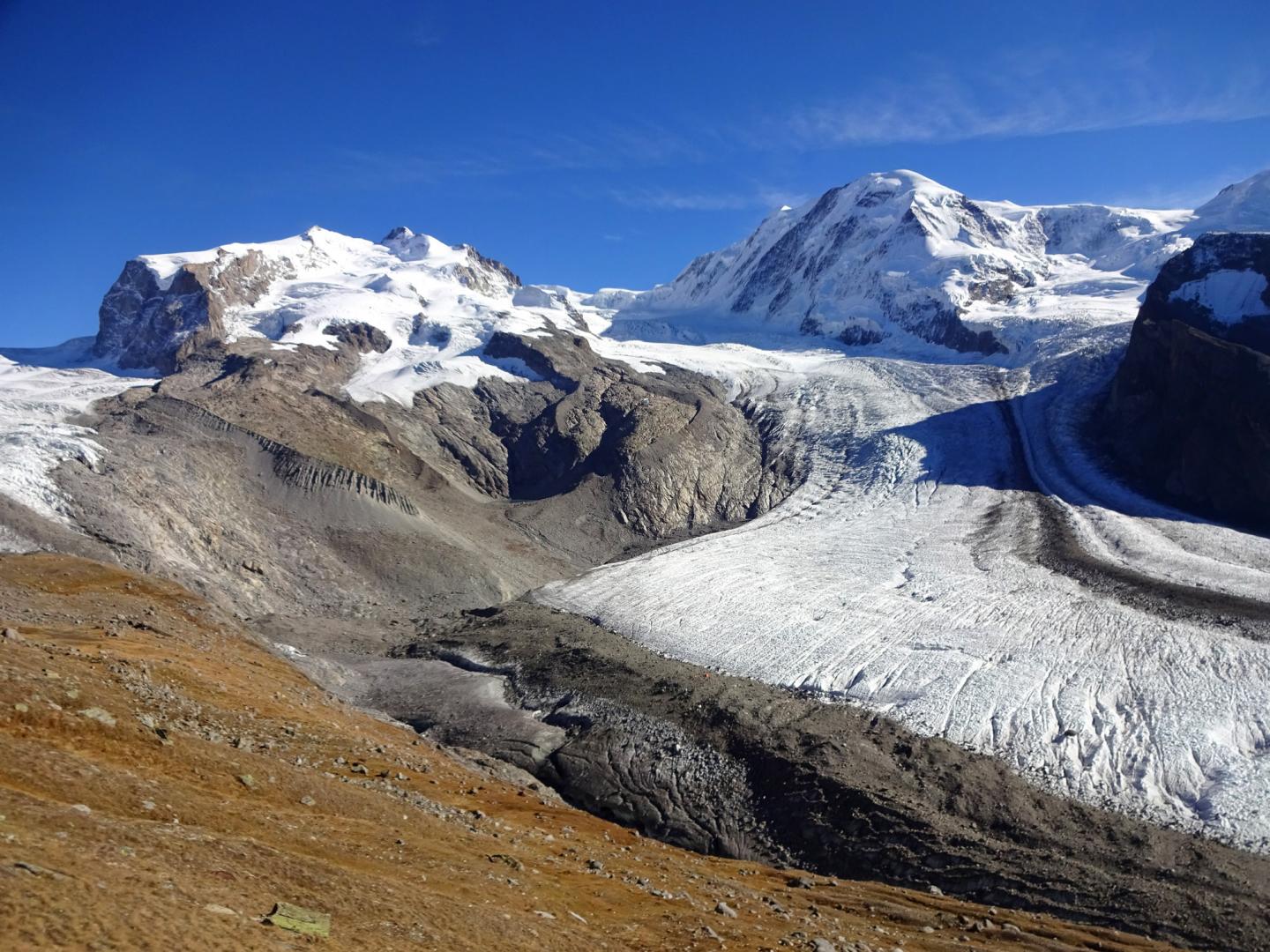Europe’s Alps could be ice-free by 2100, according to TU Delft researcher Harry Zekollari. He is modelling how glaciers around the world will fare under a warming climate.
Gorner glacier at the end of the summer of 2017. The glacier is located in the Monte Rosa massif and is the second largest glacier of the European Alps. (Photo: M. Huss)
How much glacier volume will be left on earth by the end of the century? A TU Delft research team is set to find out with a two year Marie Skłodowska-Curie Action funded project. The project chief is Harry Zekollari, a Belgian researcher who until recently worked at ETH Zurich. His two research partners are satellite imagery experts Stef Lhermitte and Bert Wouters. Both are Belgians as well. “We are called the Belgian gang here at the Department of Geoscience and Remote Sensing,” says Zekollari. “It came about by pure chance.”
Jokes aside, the signs look grim. Zekollari has shown in a recent study published in the European Geosciences Union (EGU) journal The Cryosphere earlier this month, that the European Alps could be ice-free by 2100. Other researchers had already predicted this previously: if we continue on this path, there will hardly be any ice left by the end of the century. What is new, and even more disturbing about Zekollari’s finding, is that the future of the glaciers looks grim even if we stop emitting greenhouse gasses altogether.
“Say for argument’s sake that temperatures stop rising as of today, which is of course impossible, we would still lose a substantial fraction of the total ice mass in the coming decades,” says the TU Delft researcher.
A glacier is like a conveyor belt
This has to do with gravity. Glaciers can be seen as a kind of conveyor belt. Winter snowfall exceeds summer melt at high altitudes. The snow is compacted into ice and the force of gravity slowly pushes it down the mountain slope to lower altitudes where, at a certain point, it does melt. This ice mass transfer within glaciers, from high to low elevation occurs over long time periods. As a consequence, changes in climatic conditions can take up to several decades to be translated into glacier geometry changes.
“In short, glaciers at present have ‘too much’ ice: their volume, especially at lower elevations, still reflects the colder climate of the past because glaciers are slow at responding to changing climate conditions,” says Zekollari. “Even if we do manage to stop the climate from warming any further and kept it at the level of the past 10 years, glaciers would still lose about 40% of their present-day volume by 2050 because of this ‘glacier response time’.”
After 2050, the future evolution of glaciers will strongly depend on how the climate evolves. Under a scenario of limited warming, called RCP2.6, emissions of greenhouse gases would peak in the next few years and then decline rapidly to eventually reach zero, keeping the level of added warming at the end of the century below 2°C since pre-industrial levels (which is the goal of the Paris agreement). In this case, Alpine glaciers would be reduced to about 37 cubic kilometres by 2100, just over one-third of their present-day volume.
Only isolated ice patches
Under the high emissions scenario, corresponding to RCP8.5, emissions would continue to rise rapidly over the next few decades. In this pessimistic scenario, the Alps will be mostly ice-free by 2100, with only isolated ice patches remaining at high elevation, representing 5% or less of the present-day ice volume. Global emissions are currently just above what is projected by this scenario.
‘We were the first to run these type of glacier evolution models at a regional scale’
To understand how the approximately 3,500 glaciers in the European Alps will respond to changing 21st century climatic conditions, Zekollari ran models taking ice dynamics and surface mass balance into account. “We were the first to run these type of glacier evolution models at a regional scale taking the effects of mass transfer through gravity into account. Others have done this before, but only by looking at a single or several glaciers.”
Model all the glaciers in the world
Now he and his two new TU Delft colleagues want to do the same kind of research at TU Delft, but then for all the glaciers in the world. “This is a complicated task. The European Alps are quite simple to model. All the ice there is more or less the same temperature, just below zero degrees. The ice of glaciers in the Himalayas and in Alaska ranges in temperature from 0°C degrees down to temperatures in the order of -20°C to -30°C. The colder the ice, the more rigid it becomes. So that is a factor we have to take into account in our model. What’s more, glaciers in some parts of the world end in the sea, which also influences their evolution and is difficult to represent in a global model.”
To verify the accuracy of the new model, the scientists will simulate the evolution of glaciers over the last decades and compare their findings with data from this period obtained by satellites.
Do you have a question or comment about this article?
tomas.vandijk@tudelft.nl


Comments are closed.